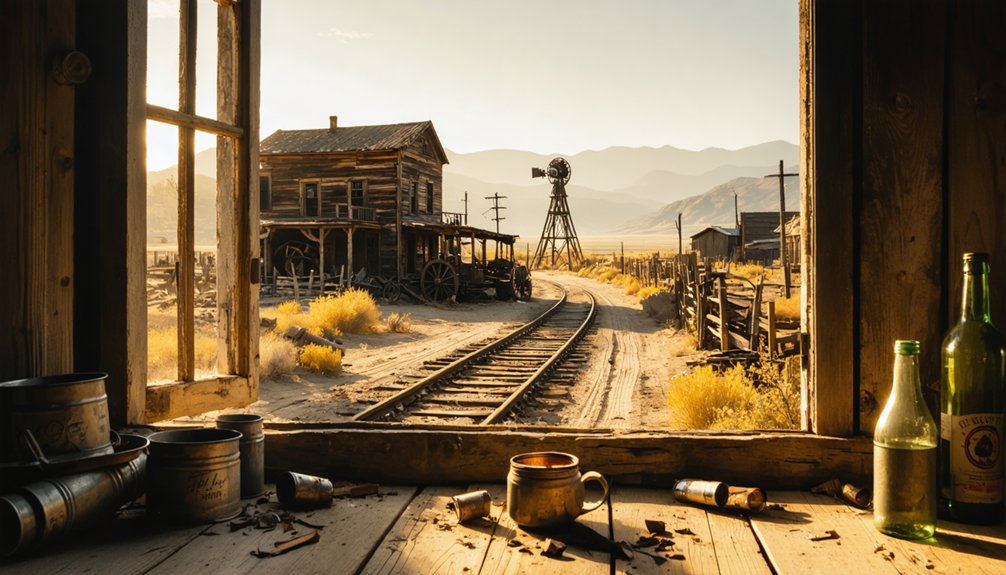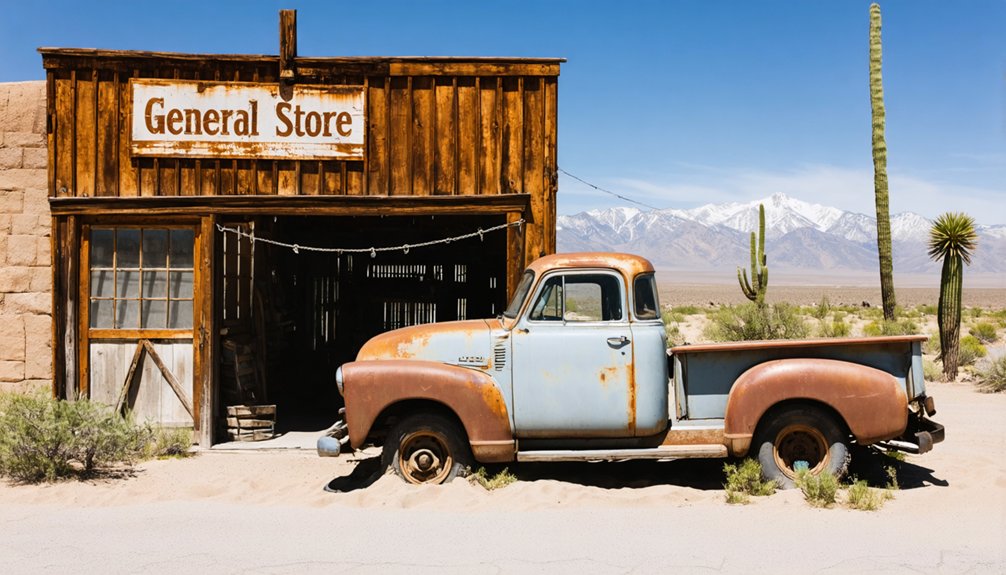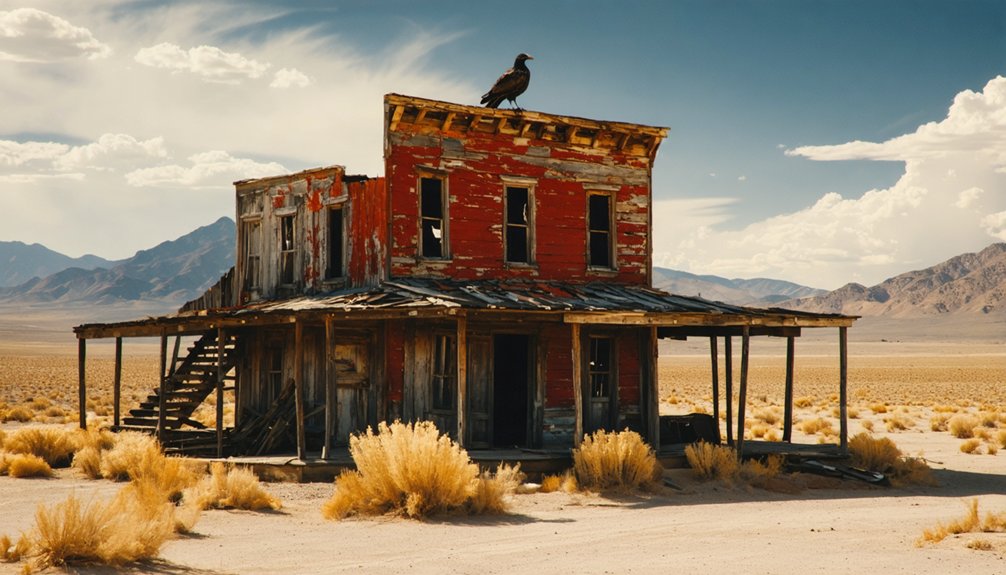You’ll find Bondville, a former Gold Rush mining camp, about a mile east of Benton Mills in California. The town flourished in the late 1840s with placer mining operations along the Merced River, featuring 65 drinking establishments and a post office from 1855-1860. While mining operations like the Bondurant Mine yielded $390,000 in gold through 1942, the town eventually declined as miners moved on. Today, this uninhabited ghost town stands as a monument to California’s rich mining heritage.
Key Takeaways
- Bondville originated as a California Gold Rush placer mining camp near Benton Mills, with operations primarily focused along the Merced River.
- During its peak years (1877-1882), Bondville produced $38 million in gold and silver before declining due to depleted resources.
- The town featured 65 drinking establishments and peaked seasonally, with population dropping to 150 during challenging winter months.
- Today, Bondville stands as an uninhabited ghost town with abandoned structures and no tourist facilities or permanent residents.
- The site lacks official preservation management but remains protected under California state law against looting and destruction.
Origins of the California Mining Settlement
As the California Gold Rush swept through the Sierra Nevada foothills in the late 1840s, Bondville emerged as a placer mining camp along the Merced River in Mariposa County during the 1850s.
You’ll find its historic location about a mile east of Benton Mills, near what became known as the Bondurant Mine site.
The settlement’s mining techniques focused on extracting gold from river sediments in the Kinsley and Greeley Hill Mining Districts.
From 1855 to 1860, you could’ve visited the camp’s post office, run by a storekeeper named Stephan.
For five years, the heart of Bondville’s communications flowed through Stephan’s post office, where miners gathered for news and mail.
Like other camps that ran out of gold, Bondville was abandoned as miners moved on to seek new strikes.
The town likely got its name from either Stephan or James A. Bondurant, a prominent mine owner and county judge.
Today, Bondville stands as a ghost town, marking one of many temporary settlements that once dotted California’s gold-rich landscape.
Much like nearby Lake McClure, which later submerged several historic mining towns, the area’s landscape has changed dramatically since the mining era.
Life in Early Bondville
While the promise of gold drew countless settlers to Bondville in the 1850s, daily life in this mining camp proved remarkably austere. During its peak years, the town boasted sixty-five drinking establishments along its streets.
You’d find families living in simple dugout houses built into hillsides, using local stone and timber for basic shelter. The settlement’s cultural traditions centered around the saloon, where miners gathered to share local folklore and escape their daily hardships. The population would drastically drop to 150 during winter, making survival even more challenging for those who remained.
You couldn’t rely on steady supplies, so you’d often barter with neighbors, trading gold dust for essential goods. When you weren’t panning for gold, you’d hunt or gather food to survive.
Life was particularly challenging during harsh winters, and without proper medical care, injuries and illness took their toll. Children split their time between helping at home and attending the makeshift schoolhouse when services were available.
Gold Rush Migration and Population Growth
During the 1850s, you’d have found prospectors flooding into Bondville from established ports like San Francisco, having braved the treacherous 2,000-mile overland route or dangerous sea voyages around Cape Horn.
As the camp’s population swelled with fortune-seekers from the East Coast, Europe, and beyond, makeshift tents and rough wooden structures dotted the hillsides near promising gold deposits. The miners faced stiff competition as over 300,000 people arrived in California by 1852. These prospectors used simple tools like pans and rockers to extract gold from the dirt and streams.
You’d have witnessed miners living in cramped, unsanitary conditions as they worked claims from sunup to sundown, often sharing basic supplies and dealing with limited access to fresh food and clean water.
Prospector Origins and Routes
The discovery of gold at Sutter’s Mill near Coloma on January 24, 1848, sparked an unprecedented wave of migration to California from across the globe.
You’d find prospector demographics ranging from young American men to adventurous souls from China, South America, and Europe, all seeking their fortune in the goldfields.
If you wanted to reach California’s riches, you’d face three main migration challenges: a grueling 2,000-mile overland journey across harsh terrain and disease-ridden territories, a lengthy sea voyage around Cape Horn, or a faster but perilous crossing through the Isthmus of Panama.
These determined pioneers, known as the Forty-Niners, braved incredible hardships in their quest for gold.
Once you arrived, you’d likely follow the river valleys to bustling mining sites like Bondville.
San Francisco emerged as an essential gateway, transforming from a small port into a booming commercial hub serving these determined fortune-seekers.
The Baltimore Sun first broke the news of the gold discovery, igniting widespread interest that would draw thousands to California’s shores.
Population Surges During 1850s
As California’s gold fields beckoned to fortune seekers worldwide, the territory’s population skyrocketed from 150,000 in 1847 to over 308,000 by 1860.
You’ll find the most dramatic population dynamics during 1849-1852, when thousands poured into the region monthly. In 1852 alone, 67,000 newcomers arrived, including 20,000 Chinese immigrants. Living conditions were harsh, and one in five newcomers died within their first six months of arrival.
Settlement patterns show Americans made up about half the arrivals, while the rest included Europeans, Latin Americans, and others from across the globe. Women were drastically underrepresented, with only 700 female arrivals by ship in 1849.
San Francisco exemplified this explosive growth, expanding from 500 residents to 60,000 by the mid-1850s. Boomtowns like Bondville sprouted up as migrants sought their fortunes.
As gold sources dwindled in the late 1850s, the population surge slowed, and communities began focusing on more stable economic activities.
Mining Camp Living Conditions
Life in mining camps proved brutally harsh for those who sought fortune in California’s goldfields. You’d find yourself living in hastily built shelters made from whatever materials were available, offering little protection from the elements.
Water access was a constant struggle, often requiring communal efforts to transport it from miles away.
Social interactions centered around the camp’s store and post office, where you’d gather essential supplies and news. Despite the challenges, resource management became a shared responsibility as you’d rely on fellow miners for survival.
You’d face daily hardships including poor sanitation, disease outbreaks, and isolation from established towns. While some camps eventually developed into proper settlements with wooden houses, most remained primitive, temporary communities where vigilante justice prevailed and cultural tensions simmered beneath the surface.
Mining Operations and Economic Activities

Mining operations in Bondville centered primarily on placer mining along the Merced River and its tributaries, where prospectors worked the rich gold-bearing gravels.
The Cherokee/Shimer Mine introduced more sophisticated operations with its ten-stamp mill from 1858-1863, representing a shift toward mechanized processing. Economic fluctuations influenced the camp’s prosperity, with the post office operating from 1855-1860 during peak activity.
- Bondurant Mine yielded $390,000 in gold between 1856-1942
- Private investors funded critical infrastructure like stamp mills
- Local leaders combined public service with mining enterprises
- Store and post office supported miners’ daily needs
- Labor force included independent prospectors and mill workers
The camp’s economic importance depended on gold prices, accessible deposits, and technological capabilities, ultimately declining as placer deposits became depleted.
Daily Challenges of Frontier Living
The harsh realities of frontier existence in Bondville extended far beyond the challenges of mining operations.
You’d face brutal winters with deep snow that cut you off from civilization for months, followed by scorching summers with scarce water. Your survival strategies had to account for frequent shortages of food, medicine, and basic supplies, while paying premium prices for whatever goods made it through.
Community resilience was tested daily as you’d cope with minimal medical care, rampant diseases, and injuries from mining accidents. Without hospitals, you’d rely on home remedies and local healers.
Your hastily built home offered little protection from the elements, and you’d haul water from distant sources. The constant threat of fires, combined with poor sanitation and unreliable law enforcement, made each day a test of endurance.
Relations With Neighboring Mining Towns

During its peak years, Bondville maintained complex relationships with neighboring mining settlements through an intricate web of economic and social connections.
The inter town dynamics evolved as miners moved seasonally between locations, following promising ore discoveries. You’d find shared infrastructure like roads, telegraph lines, and essential services connecting these frontier communities.
Miners flowed between settlements like water seeking gold, leaving trails of roads and telegraph wires in their wake.
Cultural exchanges flourished as diverse immigrant groups settled across multiple towns, creating lasting bonds through:
- Shared religious services and educational facilities
- Joint mining associations and labor unions
- Cooperative trade networks for supplies and equipment
- Common social gatherings and celebrations
- Mutual support during external threats
When mining yields declined, these relationships transformed as towns faced collective hardships.
Communities consolidated resources, formed joint ventures, and sometimes merged populations as residents relocated to more viable settlements.
The Decline of Mining Operations
You’ll find that by the late 19th century, Bondville’s mining equipment had fallen into severe disrepair as operators couldn’t afford proper maintenance or essential upgrades to compete with larger operations.
The town’s miners struggled with frequent breakdowns of outdated machinery while facing rising repair costs and diminishing gold yields.
These technical challenges, combined with plummeting gold prices and increased operational expenses, pushed many of Bondville’s small mining operations to the brink of closure.
Mining Equipment Deterioration
While mining operations flourished in Bondville throughout its peak years, deteriorating equipment became a vital factor in the town’s eventual decline. The harsh mining environment quickly took its toll on essential machinery, from ore cars to stamp mills.
You’d find equipment deterioration accelerated due to water damage, particularly in flooded mine shafts where pumping systems became inoperable. Without proper maintenance, wooden structures rotted and metal components rusted beyond repair.
- Stamp mills suffered mechanical fatigue, reducing crushing efficiency
- Water infiltration caused widespread corrosion in underground machinery
- Environmental exposure destroyed exposed crushers and mills
- Labor shortages prevented routine equipment maintenance
- Technological obsolescence made older equipment impractical to repair
The lack of replacement parts and skilled technicians in Bondville’s remote location further hastened the decline, ultimately leading to abandoned machinery throughout the site.
Economic Hardships Intensify
As World War I drew to a close, Bondville’s mining operations faced devastating economic pressures that would ultimately seal the town’s fate.
You’d have witnessed potash prices plummet while fierce competition from other mining regions squeezed profit margins to breaking points. The mines couldn’t keep up with mounting operational costs as aging infrastructure crumbled and harsh weather conditions damaged essential equipment.
Economic migration hit the town hard as workers left in search of stable employment elsewhere.
These labor shortages created a vicious cycle – fewer workers meant reduced production capacity, while declining revenues prevented necessary technological upgrades. Local businesses that once thrived by serving the mining community began to fold.
The combination of market instability, rising maintenance costs, and dwindling workforce sealed Bondville’s transformation into a ghost town.
Modern-Day Ghost Town Status

Today, Bondville stands as a reflection of California’s rural decline, with its largely uninhabited streets and deteriorating structures marking its status as a modern ghost town.
You’ll find no active housing market or ghost town tourism infrastructure here, unlike more developed abandoned towns. The absence of permanent residents and minimal maintenance has left most properties in a state of disrepair, with limited visitor access and no modern amenities.
- No permanent residents maintain the community
- Buildings remain largely abandoned and deteriorating
- Lack of tourist facilities or organized activities
- Property values remain stagnant or severely reduced
- Economic revitalization efforts are currently non-existent
The town’s current condition serves as a stark reminder of regional economic shifts, with its abandoned structures and overgrown pathways telling the story of a once-active community now frozen in time.
Historical Preservation Efforts
You’ll find Bondville’s preservation follows similar “arrested decay” protocols used at other California ghost towns, with state agencies working to stabilize remaining structures while maintaining their weathered appearance.
Professional photographers have extensively documented the site’s deterioration through seasonal images that help preservation teams track structural changes and prioritize urgent stabilization needs.
Archaeological surveys protect important artifacts and building foundations from vandalism and natural erosion, ensuring this historic mining settlement remains intact for future study.
Current Preservation Status
Despite extensive research efforts, no official preservation records exist specifically for Bondville’s historical structures or artifacts.
When compared to well-documented ghost towns like Bodie, you’ll find Bondville faces unique preservation challenges without formal state protection or management.
While Bodie operates under California’s “arrested decay” approach, Bondville lacks institutional oversight to protect its remaining features.
- No designated state park status or legal protections
- Absence of formal visitor regulations or site monitoring
- No documented inventory of surviving structures
- Limited historical documentation of preservation efforts
- No organized funding mechanisms for conservation
Without official management like Bodie’s state park system, Bondville remains vulnerable to environmental damage, vandalism, and artifact removal.
The site’s current condition reflects this absence of structured preservation measures, contrasting sharply with ghost towns that benefit from active conservation programs and institutional support.
Documentation Through Photography
Photography played an essential role in preserving Bondville’s legacy, though records remain sparse compared to other ghost towns. The earliest photographic techniques captured the town’s evolution from the late 19th century, employing glass plate negatives and early film to document its structures and daily life.
You’ll find these images preserved in historical societies and archives, offering glimpses into the town’s bustling past. Visual storytelling through photography continues to guide preservation efforts today.
Park staff use before-and-after photographs to monitor deterioration and plan maintenance, while guided tours incorporate historic images to help you envision the town’s former vibrancy.
Despite challenges like harsh weather conditions and restricted winter access, ongoing documentation through photography workshops and permitted drone imaging guarantees Bondville’s history remains accessible for future generations.
Archaeological Site Protection
While many ghost towns face deterioration and vandalism, Bondville benefits from extensive legal protections under California state law and federal statutes like ARPA and NHPA.
Archaeological ethics guide preservation strategies through arrested decay methods and regulated excavation protocols, ensuring the site’s authenticity remains intact for future generations.
- State agencies enforce anti-looting laws to protect archaeological artifacts
- Structural reinforcements maintain original appearances while preventing collapse
- Qualified archaeologists must oversee all excavation activities
- Restricted access zones shield fragile areas from visitor damage
- Regular maintenance programs address weathering and human impact
You’ll find thorough site protection measures in place, from erosion control to vegetation management.
These efforts protect subsurface findings while allowing controlled public access through guided tours and interpretive programs that highlight the importance of preserving this historic mining town.
Legacy in California’s Mining Heritage
Because of its notorious reputation and remarkable gold production, Bondville left an indelible mark on California’s mining heritage.
You’ll find the town’s Bodie legacy woven into mining folklore through its famous “Badman from Bodie” reputation, which rivaled even Tombstone and Dodge City for Wild West infamy.
Between 1877 and 1882, the town’s peak years produced an astounding $38 million in gold and silver, supporting over 2,000 buildings, 62 saloons, and a booming economy.
Bodie’s five golden years saw millions in precious metals fuel explosive growth, turning a mining camp into a booming frontier metropolis.
Today, you can still experience this rich history firsthand at what’s now Bodie State Historic Park, where 170+ buildings remain preserved in “arrested decay.”
As California’s official State Gold Rush Ghost Town since 2002, it offers you an authentic glimpse into the raw, untamed spirit of the mining boom era.
Frequently Asked Questions
Are There Any Reported Ghost Sightings or Paranormal Activities in Bondville?
You won’t find documented ghostly encounters or paranormal investigations specific to Bondville. While nearby ghost towns like Bodie have extensive supernatural reports, Bondville lacks credible evidence of paranormal activity.
What Specific Treasures or Artifacts Have Been Discovered by Modern Explorers?
You’ll find lost relics like mining tools, sluice boxes, and gold nuggets scattered across the ruins. Modern explorers have uncovered coins, personal items, Native American artifacts, and metal tokens.
Can Visitors Legally Take Home Small Artifacts Found at Bondville?
You can’t legally remove artifacts from Bondville due to artifact preservation laws and legal restrictions. Even small items like bottles or nails must stay onsite to protect the site’s historical integrity.
How Accessible Is Bondville by Car During Different Seasons?
Like a miner’s luck, your access varies wildly. You’ll need 4WD in winter’s snow and spring’s mud, but summer brings easier driving. Fall’s stable conditions make it your best bet.
Are There Guided Tours or Designated Camping Areas Near Bondville?
You won’t find official guided tours here. For guided exploration, check nearby historical societies. Camping regulations restrict overnight stays at the site, but you’ll find designated campgrounds in surrounding national forests.
References
- https://nvtami.com/2024/01/20/monoville-califoria-ghost-town/
- https://en.wikipedia.org/wiki/Bodie
- https://www.snowcreekresort.com/blog/bone-chilling-history-bodie-ghost-town/
- https://www.youtube.com/watch?v=-MVcI3ACr9A
- https://www.bodie.com
- https://jasondanielshaw.com/blog/best-ghost-town-in-california-bodie
- https://www.monocounty.org/places-to-go/bodie/
- https://westernmininghistory.com/state/california/
- https://freepages.rootsweb.com/~gtusa/history/usa/ca/mrp-co/b.htm
- https://www.survivorlibrary.com/library/the_gold_fields_of_lower_california_1889.pdf



